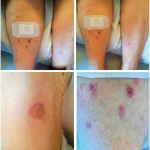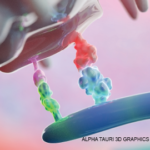Although several studies show great promise and survival benefits with these new medications, they also come with a potential disadvantage. Manipulating the off switch in the immune system could lead to autoimmune diseases and systemic inflammatory reactions, also known as immune-related adverse events (irAEs).1,3 Reported irAEs include rash, pneumonitis, hepatitis, colitis and hypothyroidism.2,4 Rheumatic irAEs are rare, and data regarding these side effects are limited.
In a case series reported by Calabrese et al., 15 patients were followed over an 18-month period. Of these, 13 patients with no preexisting autoimmune disease and two with an existing autoimmune disease reported several rheumatic irAEs, including inflammatory arthritis, sicca syndrome, polymyalgia rheumatica (PMR)-like symptoms and myositis.3
In the Calabrese study, the median time to onset of rheumatic irAEs was 7.3 weeks after initiating immunotherapy, with the exception of two patients who didn’t develop rheumatic irAEs until after more than a year. The longest time to onset was more than four years, in a patient receiving nivolumab for treatment of renal cell carcinoma who developed a PMR-like syndrome. One patient with preexisting psoriatic arthritis experienced an arthritis flare 2.8 weeks after initiating immunotherapy.3 Our patient described above had a prolonged time (11 months) to onset of his psoriasis flare and new psoriatic arthritis manifestations following the initiation of nivolumab.
The incidence of arthralgia secondary to nivolumab was reported at 5–16%, but the incidence of inflammatory arthritis remains unclear (probably due to poor documentation and a non-standardized coding system).5 In addition, some prescribers could have a lower suspicion of potential adverse effects of ICIs. Whether or not the incidence of rheumatic irAEs is increased in people with preexisting autoimmune disease remains unknown. In the case above, our patient did have a history of psoriasis, and we hypothesize he was more susceptible to rheumatic irAEs.
This case highlights an important emerging complication related to cancer immunotherapy with nivolumab, & the need for physicians to maintain a low threshold to suspect irAEs in patients on immunotherapy.
Prednisone has remained the initial treatment in rheumatic irAEs, although no treatment algorithms exist for the dose and duration of therapy.5 Some patients described above required steroid doses as high as 120 mg of prednisone daily, but others could be treated with a lower dose.5,6 Reports have been made of inflammatory arthritis irAEs persisting up to 15 months after the last dose of ICI. These patients required more aggressive therapy with tumor necrosis factor (TNF) inhibitors to control their symptoms.6



